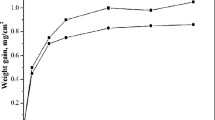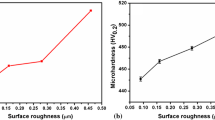Abstract
The effect of molten salts on the mechanical properties of a Ni–20Cr–18W (wt%)-based superalloy was investigated in this work. The hot corrosion characteristics and the microstructural evolution during the hot corrosion process were analyzed. The corrosion scale forms on the surface of the substrate, and its thickness increases gradually during the process. The element of S invades the substrate. The corrosion products mainly include NiO, Ni3S2 and Cr2O3. The hot corrosion in molten salt makes the specimens rough and flawed. The serration grain boundaries are observed in the hot corroded specimens. The tensile strength and elongation of the original alloy are ~1023 MPa and ~15 %, respectively. After corroded for 5 h, the tensile strength and elongation of the specimen decrease to ~771 MPa and ~7 % and diminish to ~814 MPa and ~9 % for the specimen corroded for 10 h. The hot corrosion process deteriorates the mechanical properties of the alloys. And the tensile strength and elongation of the specimen corroded for 20 h sharply decrease to ~539 MPa and ~3 %, respectively. The nonmonotonic variation of the mechanical properties of the specimen occurs for the specimens corroded for 10 h, which is related to the competition between the depredation of the molten salts and the strengthening process by carbides and the serrated grain boundaries.
Graphical Abstract
The corrosion characteristics and microstructural evolution of a Ni–20Cr–18W-based superalloy were investigated during the hot corrosion process. It is found that the attack of molten salts makes the tensile strength of the specimens deteriorate significantly. The nonmonotonic variation of mechanical properties is related to the competition between the destruction of molten salts and the strengthening process during the hot corrosion process.











Similar content being viewed by others
References
Eliaz N, Shemesh G, Latanision RM. Hot corrosion in gas turbine components. Eng Fail Anal. 2002;9(1):31.
Misra AK. Studies on the hot corrosion of a nickel-base superalloy, Udimet 700. Oxid Met. 1986;25(3–4):129.
Zinkle SJ. Was GS Materials challenges in nuclear energy. Acta Mater. 2013;61(3):735.
Liu Y, Wang XM, Cen SB, Gou GQ, Wang LJ, Chen H, Tu MJ, Li YX. Corrosion behavior of thermal-sprayed WC cermet coating in SO4 2− environment. Rare Met. 2014;33(3):318.
Kim D, Kim D, Lee HJ, Jang C, Yoon DJ. Corrosion characteristics of Ni-base superalloys in high temperature steam with and without hydrogen. J Nucl Mater. 2013;441(1):612.
Liu GM, Yu F, Tian JH, Ma JH. Influence of pre-oxidation on the hot corrosion of M38G superalloy in the mixture of Na2SO4–NaCl melts. Mater Sci Eng A. 2008;496(1–2):40.
Liu GM, Li MS, Zhou YC, Zhang YM. Influence of pre-oxidation on the hot corrosion of Ti3SiC2 in the mixture of Na2SO4–NaCl melts. Corros Sci. 2006;48(3):650.
Liu GM, Li MS, Zhou YC, Zhang YM. Corrosion behavior and strength degradation of Ti3SiC2 exposed to a eutectic K2CO3 and Li2CO3 mixture. J Eur Ceram Soc. 2003;23(11):1957.
Hu R, Bai GH, Li JS, Zhang JQ, Zhang TB, Fu HZ. Precipitation behavior of grain boundary M23C6 and its effect on tensile properties of Ni–Cr–W based superalloy. Mater Sci Eng A. 2012;548:83.
Bai GH, Li JS, Hu R, Tang ZW, Xue XY, Fu HZ. Effect of temperature on tensile behavior of Ni–Cr–W based superalloy. Mater Sci Eng A. 2011;528(4–5):1974.
Bai GH, Li JS, Hu R, Zhang TB, Kou HC, Fu HZ. Effect of thermal exposure on the stability of carbides in Ni–Cr–W based superalloy. Mater Sci Eng A. 2011;528(6):2339.
Ma J, Hu R, Chang H, Bai GH, Liu J, Zhou L. Evolution of oxidation scale for a Ni–22Cr–20Co–18W alloy at 1100 °C. Rare Met Mater Eng. 2012;41(3):486.
Li WJ, Liu Y, Wang Y, Han C, Tang HP. Hot corrosion behavior of Ni–16Cr–xAl based alloys in mixture of Na2SO4–NaCl at 600 °C. Trans Nonferr Met Soc China. 2011;21(12):2617.
Tang B, Jiang L, Hu R, Li Q. Correlation between grain boundary misorientation and M23C6 precipitation behaviors in a wrought Ni-based superalloy. Mater Charact. 2013;78:144.
Kim KJ, Hong HU, Nam SW. Investigation on the formation of serrated grain boundaries with grain boundary characteristics in an AISI 316 stainless steel. J Nucl Mater. 2009;393(2):249.
Wang D, Zhang J, Lou LH. Formation and stability of nano-scaled M23C6 carbide in a directionally solidified Ni-base superalloy. Mater Charact. 2009;60(12):1517.
Reddy GP, Harini P, Sandhya R, Rao KBS, Paretkar RK. On dual-slope linear cyclic hardening of Hastelloy X. Mater Sci Eng A. 2010;527(16):3848.
Chomette S, Gentzbittel JM, Viguier B. Creep behaviour of as received, aged and cold worked INCONEL 617 at 850 °C and 950 °C. J Nucl Mater. 2010;399(2–3):266.
Zeng YP, Kou LZ, **e XS. Influence of thermal exposure on the precipitates and mechanical properties of a newly developed Ni–21Cr–17Mo alloy. Mater Sci Eng A. 2013;560:611.
Zheng KY, Dong J, Zeng XQ, Ding WJ. Precipitation and its effect on the mechanical properties of a cast Mg–Gd–Nd–Zr alloy. Mater Sci Eng A. 2008;489(1–2):44.
Yan H, Bi HY, Li X, Xu Z. Precipitation and mechanical properties of Nb-modified ferritic stainless steel during isothermal aging. Mater Charact. 2009;60(3):204.
Wei CN, Bor HY, Chang L. The influence of carbon addition on carbide characteristics and mechanical properties of CM-681LC superalloy using fine-grain process. J Alloys Compd. 2011;509(18):5708.
Hong HU, Nam SW. The occurrence of grain boundary serration and its effect on the M23C6 carbide characteristics in an AISI 316 stainless steel. Mater Sci Eng A. 2002;332(1–2):255.
Jeong CY, Kim KJ, Hong HU, Nam SW. Effects of aging temperature and grain size on the formation of serrated grain boundaries in an AISI 316 stainless steel. Mater Chem Phys. 2013;139(1):27.
Kim KJ, Hong HU, Nam SW. A study on the mechanism of serrated grain boundary formation in an austenitic stainless steel. Mater Chem Phys. 2011;126(3):480.
Lim YS, Kim DJ, Hwang SS, Kim HP, Kim SW. M23C6 precipitation behavior and grain boundary serration in Ni-based Alloy 690. Mater Charact. 2014;96:28.
Jiang L, Hu R, Kou HC, Li JS, Bai GH, Fu HZ. The effect of M23C6 carbides on the formation of grain boundary serrations in a wrought Ni-based superalloy. Mater Sci Eng A. 2012;536:37.
Lortrakul P, Trice RW, Trumble KP, Dayananda MA. Investigation of the mechanisms of Type-II hot corrosion of superalloy CMSX-4. Corros Sci. 2014;80:408.
Acknowledgments
This study was financially supported by the National Natural Science Foundation of China (No. 51171150) and the Program of the Ministry of Education of China for Introducing Talents of Discipline to Universities (No. B08040).
Author information
Authors and Affiliations
Corresponding author
Rights and permissions
About this article
Cite this article
Dong, RF., Zhang, TB., Hu, R. et al. Hot corrosion behavior and mechanical properties degradation of a Ni–Cr–W-based superalloy. Rare Met. 36, 23–31 (2017). https://doi.org/10.1007/s12598-016-0751-2
Received:
Revised:
Accepted:
Published:
Issue Date:
DOI: https://doi.org/10.1007/s12598-016-0751-2




